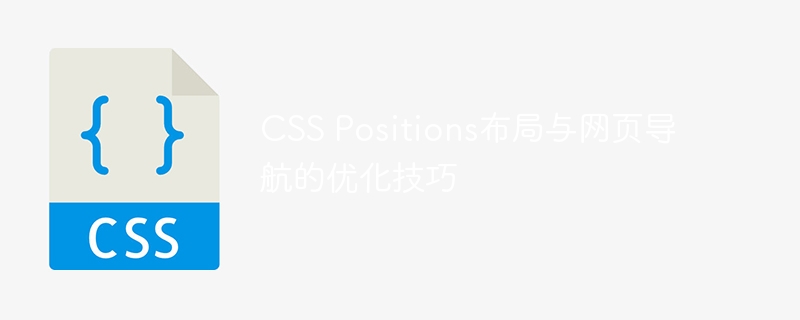

CSS Positions layout and web navigation optimization skills
In web design and development, layout and navigation are two very important aspects. A reasonable layout can make a web page look neat and beautiful, while optimized navigation can improve user experience and efficiency. In this article, we will introduce some optimization techniques for CSS Positions layout and web page navigation, and provide specific code examples.
1. CSS Positions layout
Relative positioning refers to setting the position attribute of the element to relative, and then using The top, bottom, left, and right attributes adjust the offset of the element relative to its original position. This positioning method is often used to fine-tune the position of elements, such as alignment, centering, etc.
Sample code:
<style>
.box {
position: relative;
left: 50px;
top: 50px;
background-color: #f0f0f0;
width: 200px;
height: 200px;
}
</style>
<div class="box">相对定位示例</div>Absolute positioning refers to setting the position attribute of the element to absolute and then using top , bottom, left, and right attributes to determine the offset of the element relative to its nearest non-statically positioned ancestor element. This positioning method is often used to create overlays, pop-ups and other elements that require precise control of position.
Sample code:
<style>
.container {
position: relative;
width: 400px;
height: 400px;
}
.box {
position: absolute;
top: 50px;
left: 50px;
background-color: #f0f0f0;
width: 200px;
height: 200px;
}
</style>
<div class="container">
<div class="box">绝对定位示例</div>
</div>Fixed positioning refers to setting the position attribute of the element to fixed, and then using top , bottom, left, and right attributes to determine the offset of the element relative to the browser window. This positioning method is often used to create elements that are fixed at a certain location on the page, such as navigation bars, advertising floating layers, etc.
Sample code:
<style>
.navbar {
position: fixed;
top: 0;
left: 0;
width: 100%;
background-color: #f0f0f0;
height: 50px;
}
</style>
<div class="navbar">固定定位示例</div>2. Optimization techniques for web navigation
With With the popularity of mobile devices, responsive design has become an essential skill. For navigation, responsive design allows the navigation to automatically adjust its layout on screens of different sizes, providing a better user experience.
Sample code:
<style>
.navbar {
display: flex;
flex-direction: column;
}
@media screen and (min-width: 768px) {
.navbar {
flex-direction: row;
}
}
</style>
<div class="navbar">
<a href="#">首页</a>
<a href="#">产品</a>
<a href="#">服务</a>
<a href="#">联系我们</a>
</div>Adding hover effects to navigation can improve the user's interactive experience. Through the CSS hover pseudo-class, we can set the style when the mouse hovers over the navigation link, such as changing the text color, background color, adding animation effects, etc.
Sample code:
<style>
.navbar {
display: flex;
}
.navbar a {
padding: 10px;
text-decoration: none;
color: #333;
transition: color 0.3s;
}
.navbar a:hover {
color: #ff0000;
}
</style>
<div class="navbar">
<a href="#">首页</a>
<a href="#">产品</a>
<a href="#">服务</a>
<a href="#">联系我们</a>
</div>Adding animation effects to navigation can make the page more lively and interesting. We can use the transition property and transform property of CSS to achieve smooth transition and animation effects of navigation.
Sample code:
<style>
.navbar {
display: flex;
}
.navbar a {
padding: 10px;
text-decoration: none;
color: #333;
transition: transform 0.3s;
}
.navbar a:hover {
transform: scale(1.2);
}
</style>
<div class="navbar">
<a href="#">首页</a>
<a href="#">产品</a>
<a href="#">服务</a>
<a href="#">联系我们</a>
</div>Summary:
By rationally using CSS Positions layout and optimizing web navigation techniques, we can create more beautiful and efficient web pages. I hope these code examples can inspire your web design and development, improve user experience and improve work efficiency.
The above is the detailed content of CSS Positions layout and web navigation optimization techniques. For more information, please follow other related articles on the PHP Chinese website!